Metabolomic Approach for Discrimination of Cultivation Age and Ripening Stage in Ginseng Berry Using Gas Chromatography-Mass Spectrometry
Abstract
1. Introduction
2. Results and Discussion
2.1. Metabolic Profiling of GB with Different Cultivation Ages and Ripening Stages
2.2. Metabolic Changes of GB by Ripening Stage
2.3. Metabolic Differences Between Three-Year-Old GB and Four-Year-Old GB
2.4. Classification of GB by Random Forest Machine Learning Algorithm
3. Materials and Methods
3.1. Plant Materials and Preprocessing
3.2. Sample Derivatization
3.3. GC-MS Analysis
3.4. Data Processing
3.5. Random Forest Machine Learning Algorithm
3.6. Statistical Analysis
4. Conclusions
Supplementary Materials
Author Contributions
Funding
Conflicts of Interest
References
- Jeon, B.H.; Kim, C.S.; Park, K.S.; Lee, J.W.; Park, J.B.; Kim, K.J.; Kim, S.H.; Chang, S.J.; Nam, K.Y. Effect of Korea red ginseng on the blood pressure in conscious hypertensive rats. Gen. Pharmacol. 2000, 35, 135–141. [Google Scholar] [CrossRef]
- Cho, W.C.; Chung, W.S.; Lee, S.K.; Leung, A.W.; Cheng, C.H.; Yue, K.K. Ginsenoside Re of Panax ginseng possesses significant antioxidant and antihyperlipidemic efficacies in streptozotocin-induced diabetic rats. Eur. J. Pharmacol. 2006, 550, 173–179. [Google Scholar] [CrossRef]
- Kim, D.Y.; Yang, W.M. Panax ginseng ameliorates airway inflammation in an ovalbumin-sensitized mouse allergic asthma model. J. Ethnopharmacol. 2011, 136, 230–235. [Google Scholar] [CrossRef]
- Helmes, S. Cancer prevention and therapeutics: Panax ginseng. Altern. Med. Rev. 2004, 9, 259–275. [Google Scholar]
- Ko, S.K.; Bae, H.M.; Cho, O.S.; Im, B.O.; Chung, S.H.; Lee, B.Y. Analysis of ginsenoside composition of ginseng berry and seed. Food Sci. Biotechnol. 2008, 17, 1379–1382. [Google Scholar]
- Wang, C.Z.; Wu, J.A.; McEntee, E.; Yuan, C.S. Saponins composition in American ginseng leaf and berry assayed by high-performance liquid chromatography. J. Agric. Food Chem. 2006, 54, 2261–2266. [Google Scholar] [CrossRef]
- Kim, Y.K.; Yoo, D.S.; Xu, H.; Park, N.I.; Kim, H.H.; Choi, J.E.; Park, S.U. Ginsenoside content of berries and roots of three typical Korean ginseng (Panax ginseng) cultivars. Nat. Prod. Commun. 2009, 4, 903–906. [Google Scholar] [CrossRef]
- Chen, C.F.; Chiou, W.F.; Zhang, J.T. Comparison of the pharmacological effects of Panax ginseng and Panax quinquefolium. Acta Pharmacol. Sin. 2008, 29, 1103–1108. [Google Scholar] [CrossRef]
- Li, F.Y. The origin and classification of Chinese ginseng and American ginseng. In Chinese Ginseng and American Ginseng, 1st ed.; China Agricultural Scientech Press: Beijing, China, 2002; pp. 1–20. [Google Scholar]
- Lee, S.Y.; Kim, Y.K.; Park, N.I.; Kim, C.S.; Lee, C.Y.; Park, S.U. Chemical constituents and biological activities of the berry of Panax ginseng. J. Med. Plant Res. 2010, 4, 349–353. [Google Scholar]
- Dey, L.; Xie, J.; Wang, A.; Wu, J.; Maleckar, S.; Yuan, C.S. Anti-hyperglycemic effects of ginseng: Comparison between root and berry. Phytomedicine 2003, 10, 600–605. [Google Scholar] [CrossRef]
- Choi, H.S.; Kim, S.; Kim, M.J.; Kim, M.S.; Kim, J.; Park, C.W.; Seo, D.; Shin, S.S.; Oh, S.W. Efficacy and safety of Panax ginseng berry extract on glycemic control: A 12-wk randomized, double-blind, and placebo-controlled clinical trial. J. Ginseng Res. 2018, 42, 90–97. [Google Scholar] [CrossRef] [PubMed]
- Lee, H.J.; Jeong, J.; Alves, A.C.; Han, S.T.; In, G.; Kim, E.H.; Jeong, W.S.; Hong, Y.S. Metabolomic understanding of intrinsic physiology in Panax ginseng during whole growing seasons. J. Ginseng Res. 2019, 43, 654–665. [Google Scholar] [CrossRef]
- Song, H.H.; Kim, D.Y.; Woo, S.; Lee, H.K.; Oh, S.R. An approach for simultaneous determination for geographical origins of Korean Panax ginseng by UPLC-QTOF/MS coupled with OPLS-DA models. J. Ginseng Res. 2013, 37, 341–348. [Google Scholar] [CrossRef]
- Liu, J.; Liu, Y.; Wang, Y.; Abozeid, A.; Zu, Y.G.; Tang, Z.H. The integration of GC–MS and LC–MS to assay the metabolomics profiling in Panax ginseng and Panax quinquefolius reveals a tissue-and species-specific connectivity of primary metabolites and ginsenosides accumulation. J. Pharm. Biomed. Anal. 2017, 135, 176–185. [Google Scholar] [CrossRef]
- Kim, S.W.; Gupta, R.; Lee, S.H.; Min, C.W.; Agrawal, G.K.; Rakwal, R.; Kim, J.B.; Jo, I.H.; Park, S.Y.; Kim, J.K.; et al. An integrated biochemical, proteomics, and metabolomics approach for supporting medicinal value of Panax ginseng fruits. Front. Plant Sci. 2016, 7, 994. [Google Scholar] [CrossRef]
- Chung, I.M.; Kim, J.W.; Seguin, P.; Jun, Y.M.; Kim, S.H. Ginsenosides and phenolics in fresh and processed Korean ginseng (Panax ginseng CA Meyer): Effects of cultivation location, year, and storage period. Food Chem. 2012, 130, 73–83. [Google Scholar] [CrossRef]
- Chung, I.M.; Lim, J.J.; Ahn, M.S.; Jeong, H.N.; An, T.J.; Kim, S.H. Comparative phenolic compound profiles and antioxidative activity of the fruit, leaves, and roots of Korean ginseng (Panax ginseng Meyer) according to cultivation years. J. Ginseng Res. 2016, 40, 68–75. [Google Scholar] [CrossRef]
- Song, S.Y.; Park, D.H.; Seo, S.W.; Park, K.M.; Bae, C.S.; Son, H.S.; Kim, H.G.; Lee, J.H.; Yoon, G.; Shim, J.H.; et al. Effects of harvest time on phytochemical constituents and biological activities of Panax ginseng berry extracts. Molecules 2019, 24, 3343. [Google Scholar] [CrossRef]
- Kim, N.; Kim, K.; Choi, B.Y.; Lee, D.; Shin, Y.S.; Bang, K.H.; Cha, S.W.; Lee, J.W.; Choi, H.K.; Jang, D.S.; et al. Metabolomic approach for age discrimination of Panax ginseng using UPLC-Q-Tof MS. J. Agric. Food Chem. 2011, 59, 10435–10441. [Google Scholar] [CrossRef]
- Lee, M.Y.; Seo, H.S.; Singh, D.; Lee, S.J.; Lee, C.H. Unraveling dynamic metabolomes underlying different maturation stages of berries harvested from Panax ginseng. J. Ginseng Res. 2019, in press. [Google Scholar] [CrossRef]
- Yang, S.O.; Park, H.R.; Sohn, E.S.; Lee, S.W.; Kim, H.D.; Kim, Y.C.; Kim, K.H.; Na, S.W.; Choi, H.K.; Arasu, M.V.; et al. Classification of ginseng berry (Panax ginseng CA MEYER) extract using 1 H NMR spectroscopy and its inhibition of lipid accumulation in 3 T3-L1 cells. BMC Complement. Altern. Med. 2014, 14, 455. [Google Scholar] [CrossRef] [PubMed]
- Doerfler, H.; Lyon, D.; Nägele, T.; Sun, X.; Fragner, L.; Hadacek, F.; Egelhofer, V.; Weckwerth, W. Granger causality in integrated GC–MS and LC–MS metabolomics data reveals the interface of primary and secondary metabolism. Metabolomics 2013, 9, 564–574. [Google Scholar] [CrossRef] [PubMed]
- Schluter, C.; Punja, Z.K. Floral biology and seed production in cultivated North American ginseng (Panax quinquefolius). J. Am. Soc. Hortic. Sci. 2000, 125, 567–575. [Google Scholar] [CrossRef]
- Osorio, S.; Alba, R.; Nikoloski, Z.; Kochevenko, A.; Fernie, A.R.; Giovannoni, J.J. Integrative comparative analyses of transcript and metabolite profiles from pepper and tomato ripening and development stages uncovers species-specific patterns of network regulatory behavior. Plant Physiol. 2012, 159, 1713–1729. [Google Scholar] [CrossRef] [PubMed]
- Redgwell, R.J.; Fischer, M.; Kendal, E.; MacRae, E.A. Galactose loss and fruit ripening: High-molecular-weight arabinogalactans in the pectic polysaccharides of fruit cell walls. Planta 1997, 203, 174–181. [Google Scholar] [CrossRef]
- Oikawa, A.; Otsuka, T.; Nakabayashi, R.; Jikumaru, Y.; Isuzugawa, K.; Murayama, H.; Satio, K.; Shiratake, K. Metabolic profiling of developing pear fruits reveals dynamic variation in primary and secondary metabolites, including plant hormones. PLoS ONE 2015, 10, e0131408. [Google Scholar] [CrossRef]
- Mastrangelo, A.; Ferrarini, A.; Rey-Stolle, F.; García, A.; Barbas, C. From sample treatment to biomarker discovery: A tutorial for untargeted metabolomics based on GC-(EI)-Q-MS. Anal. Chim. Acta 2015, 900, 21–35. [Google Scholar] [CrossRef]
- Park, S.E.; Seo, S.H.; Kim, E.J.; Byun, S.; Na, C.S.; Son, H.S. Changes of microbial community and metabolite in kimchi inoculated with different microbial community starters. Food Chem. 2019, 274, 558–565. [Google Scholar] [CrossRef]
Sample Availability: Samples of the compounds are available from the authors. |
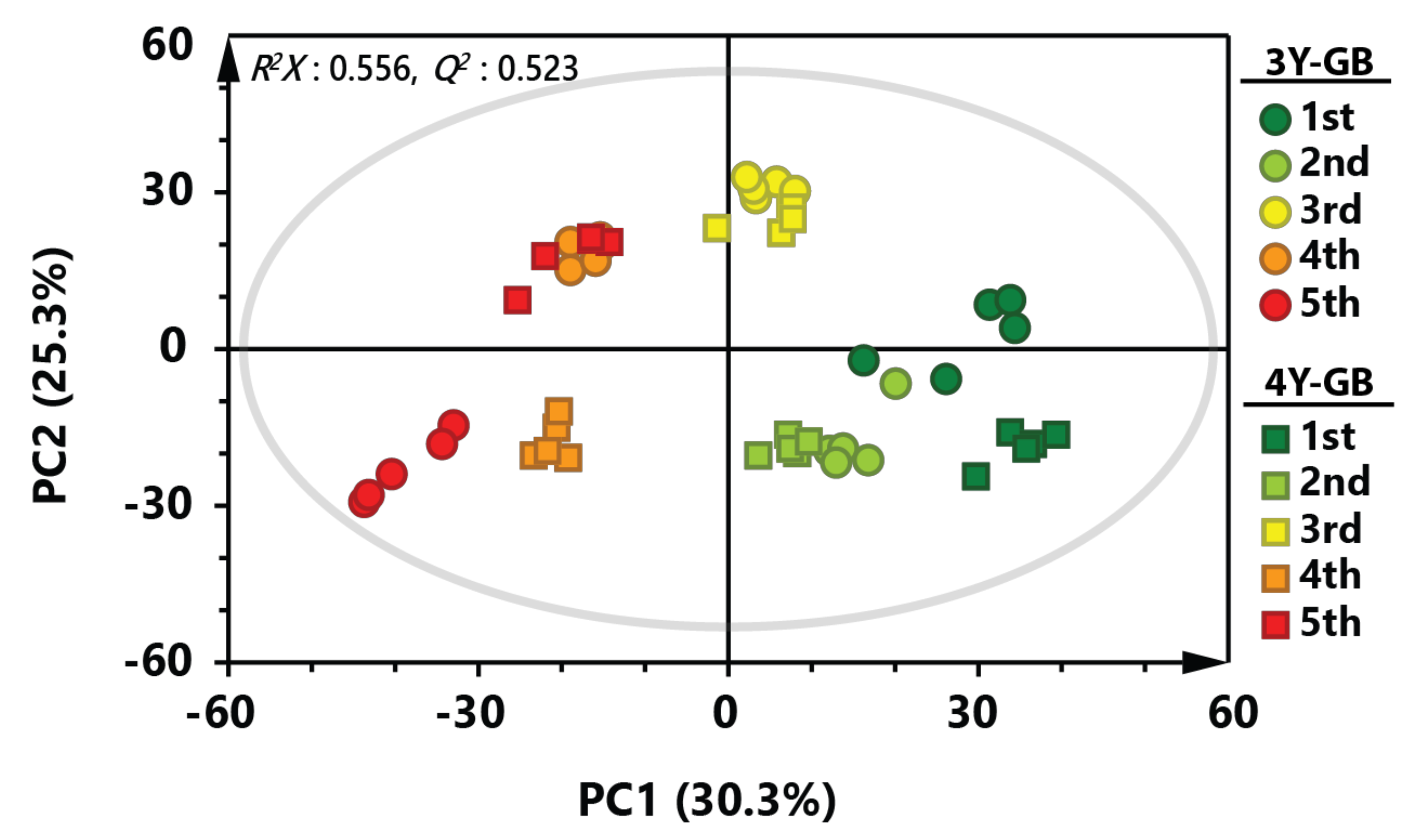
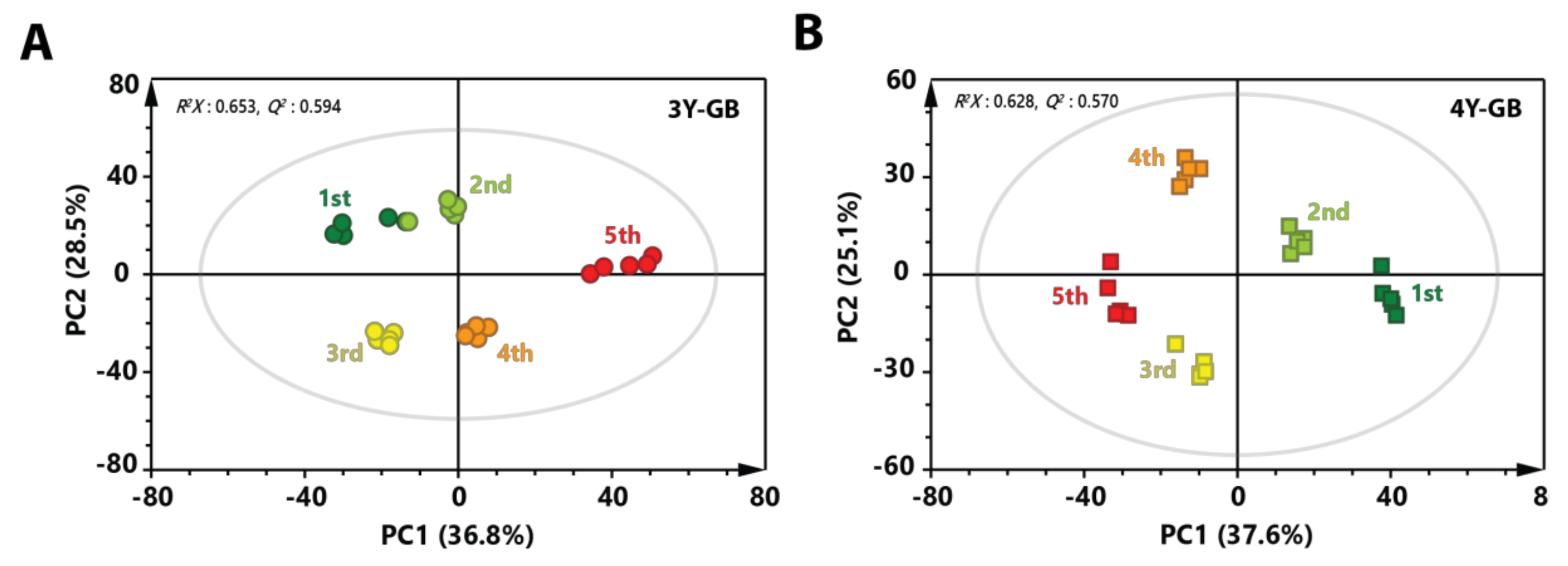
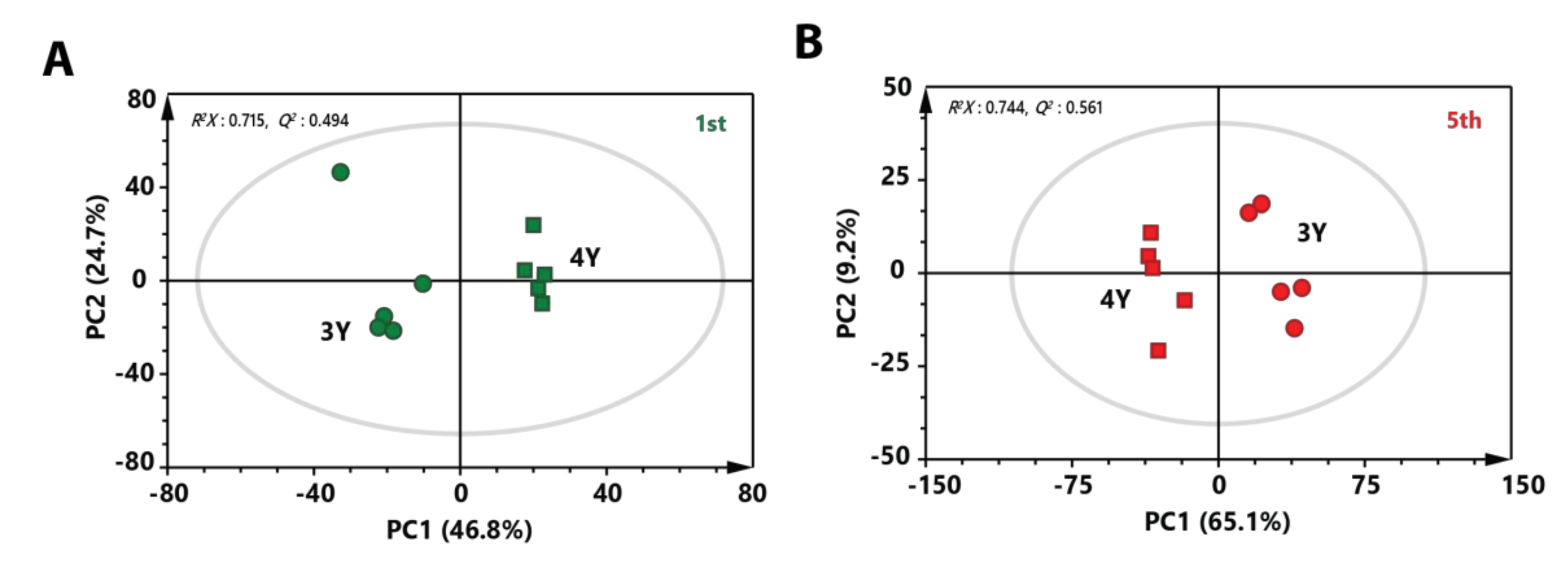
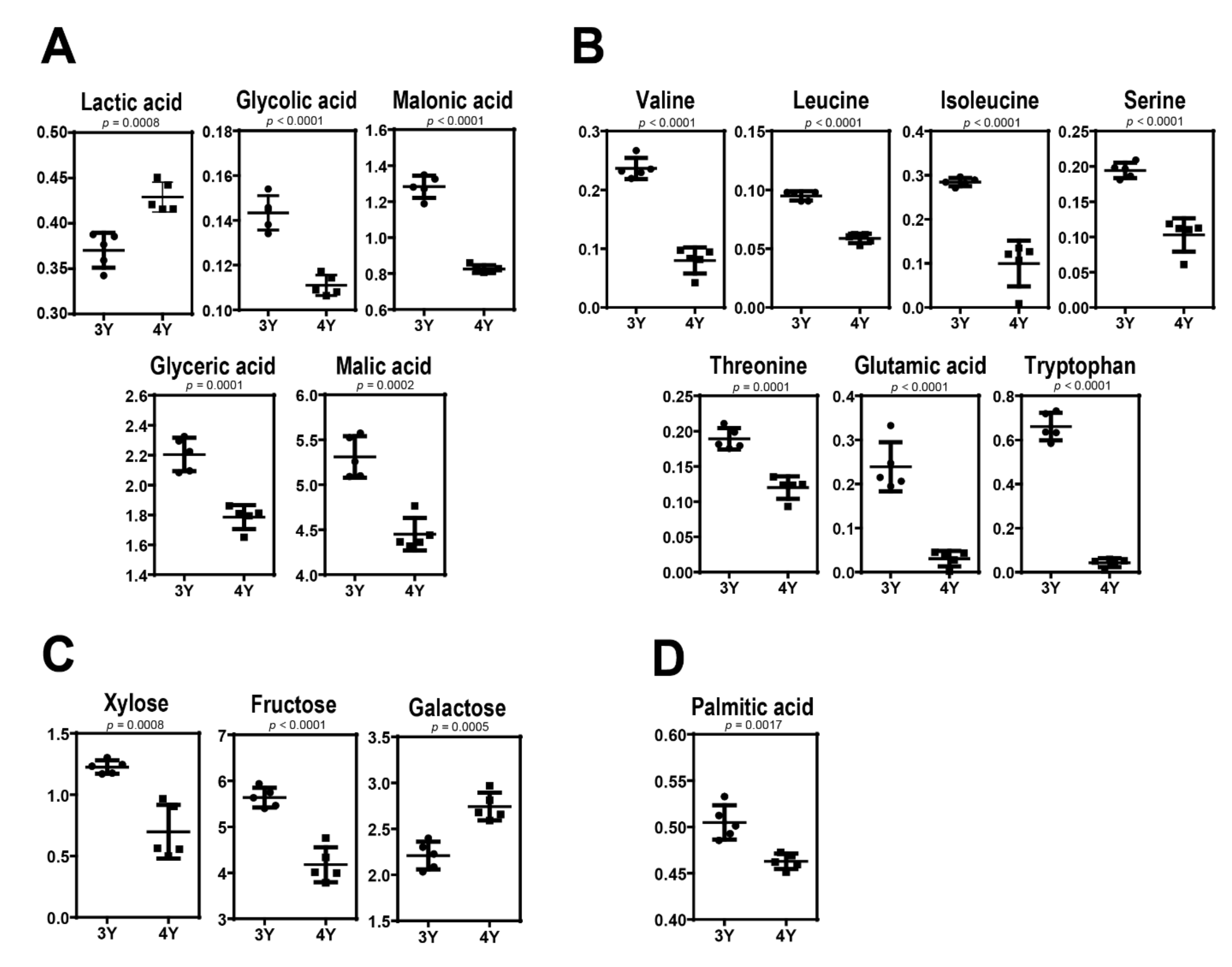
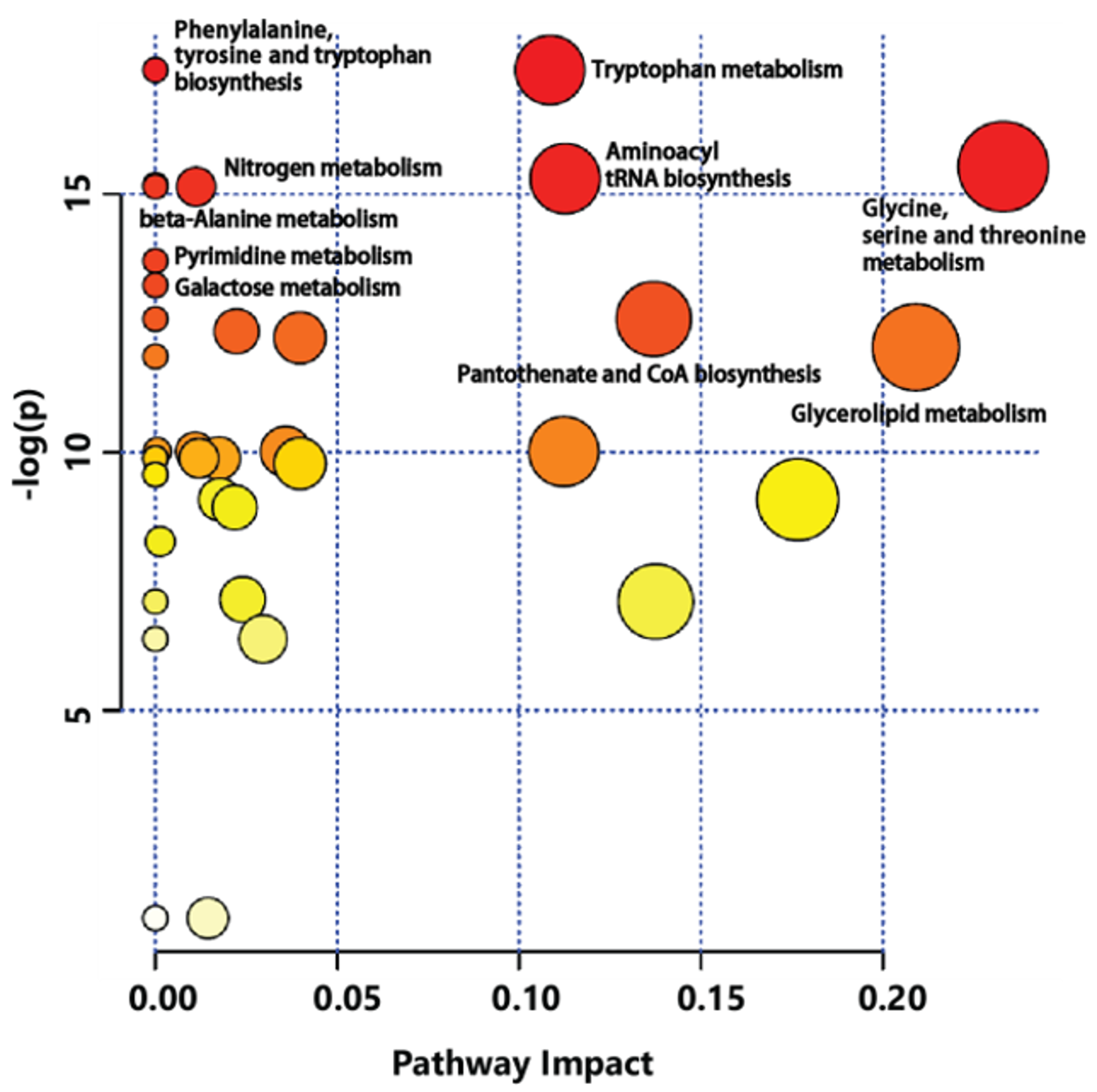

| Group | Metabolites | Three-Year-Old | Trend 1) | Four-Year-Old | Trend | ||
|---|---|---|---|---|---|---|---|
| First Harvest | Fifth Harvest | First Harvest | Fifth Harvest | ||||
| Organicacids | Lactic Acid | 0.540 ± 0.062 | 0.370 ± 0.019 | ↓(***) | 0.877 ± 0.052 | 0.429 ± 0.016 | ↓(***) |
| Glycolic acid | 0.150 ± 0.019 | 0.143 ± 0.008 | ↓(NS) | 0.138 ± 0.009 | 0.111 ± 0.005 | ↓(***) | |
| Malonic acid | 1.317 ± 0.146 | 1.283 ± 0.062 | ↓(NS) | 1.249 ± 0.083 | 0.825 ± 0.021 | ↓(***) | |
| Succinic acid | 0.933 ± 0.094 | 0.626 ± 0.077 | ↓(***) | 0.958 ± 0.049 | 0.667 ± 0.061 | ↓(***) | |
| Glyceric acid | 2.160 ± 0.169 | 2.204 ± 0.112 | ↑(NS) | 1.924 ± 0.085 | 1.785 ± 0.079 | ↓(*) | |
| Malic acid | 3.316 ± 0.287 | 5.310 ± 0.229 | ↑(***) | 3.278 ± 0.116 | 4.451 ± 0.181 | ↑(***) | |
| Amino acids | Valine | 0.223 ± 0.053 | 0.237 ± 0.018 | ↑(NS) | 0.319 ± 0.058 | 0.080 ± 0.022 | ↓(***) |
| Leucine | 0.066 ± 0.018 | 0.095 ± 0.004 | ↑(NS) | 0.080 ± 0.019 | 0.059 ± 0.004 | ↓(NS) | |
| Isoleucine | 0.322 ± 0.051 | 0.284 ± 0.009 | ↓(NS) | 0.242 ± 0.099 | 0.100 ± 0.052 | ↓(*) | |
| Serine | 0.252 ± 0.036 | 0.194 ± 0.011 | ↓(**) | 0.162 ± 0.081 | 0.103 ± 0.024 | ↓(NS) | |
| Threonine | 0.195 ± 0.039 | 0.189 ± 0.015 | ↓(NS) | 0.108 ± 0.044 | 0.120 ± 0.016 | ↑(NS) | |
| Glutamic acid | 0.337 ± 0.064 | 0.239 ± 0.056 | ↓(*) | 0.531 ± 0.046 | 0.031 ± 0.018 | ↓(***) | |
| Tryptophan | 0.361 ± 0.093 | 0.661 ± 0.063 | ↑(***) | 0.581 ± 0.067 | 0.043 ± 0.020 | ↓(***) | |
| Sugars & Sugar derivatives | Xylose | 0.925 ± 0.285 | 1.225 ± 0.055 | ↑(*) | 0.587 ± 0.254 | 0.698 ± 0.218 | ↑(*) |
| Fructose | 3.577 ± 0.285 | 5.635 ± 0.216 | ↑(***) | 2.577 ± 0.163 | 4.176 ± 0.379 | ↑(***) | |
| Glucose | 4.859 ± 0.515 | 9.367 ± 0.501 | ↑(***) | 4.094 ± 0.257 | 7.163 ± 0.411 | ↑(***) | |
| Galactose | 1.626 ± 0.234 | 2.209 ± 0.150 | ↑(**) | 1.054 ± 0.021 | 2.742 ± 0.151 | ↑(***) | |
| Glycerol | 1.983 ± 0.158 | 2.505 ± 0.071 | ↑(***) | 2.411 ± 0.052 | 2.032 ± 0.090 | ↓(***) | |
| Myo-inositol | 1.774 ± 0.377 | 1.290 ± 0.119 | ↓(NS) | 1.111 ± 0.117 | 2.290 ± 0.158 | ↑(***) | |
| Fatty acid | Palmitic acid | 0.507 ± 0.085 | 0.505 ± 0.019 | ↓(NS) | 0.521 ± 0.069 | 0.463 ± 0.008 | ↓(NS) |
© 2019 by the authors. Licensee MDPI, Basel, Switzerland. This article is an open access article distributed under the terms and conditions of the Creative Commons Attribution (CC BY) license (http://creativecommons.org/licenses/by/4.0/).
Share and Cite
Park, S.-E.; Seo, S.-H.; Kim, E.-J.; Park, D.-H.; Park, K.-M.; Cho, S.-S.; Son, H.-S. Metabolomic Approach for Discrimination of Cultivation Age and Ripening Stage in Ginseng Berry Using Gas Chromatography-Mass Spectrometry. Molecules 2019, 24, 3837. https://doi.org/10.3390/molecules24213837
Park S-E, Seo S-H, Kim E-J, Park D-H, Park K-M, Cho S-S, Son H-S. Metabolomic Approach for Discrimination of Cultivation Age and Ripening Stage in Ginseng Berry Using Gas Chromatography-Mass Spectrometry. Molecules. 2019; 24(21):3837. https://doi.org/10.3390/molecules24213837
Chicago/Turabian StylePark, Seong-Eun, Seung-Ho Seo, Eun-Ju Kim, Dae-Hun Park, Kyung-Mok Park, Seung-Sik Cho, and Hong-Seok Son. 2019. "Metabolomic Approach for Discrimination of Cultivation Age and Ripening Stage in Ginseng Berry Using Gas Chromatography-Mass Spectrometry" Molecules 24, no. 21: 3837. https://doi.org/10.3390/molecules24213837
APA StylePark, S.-E., Seo, S.-H., Kim, E.-J., Park, D.-H., Park, K.-M., Cho, S.-S., & Son, H.-S. (2019). Metabolomic Approach for Discrimination of Cultivation Age and Ripening Stage in Ginseng Berry Using Gas Chromatography-Mass Spectrometry. Molecules, 24(21), 3837. https://doi.org/10.3390/molecules24213837






